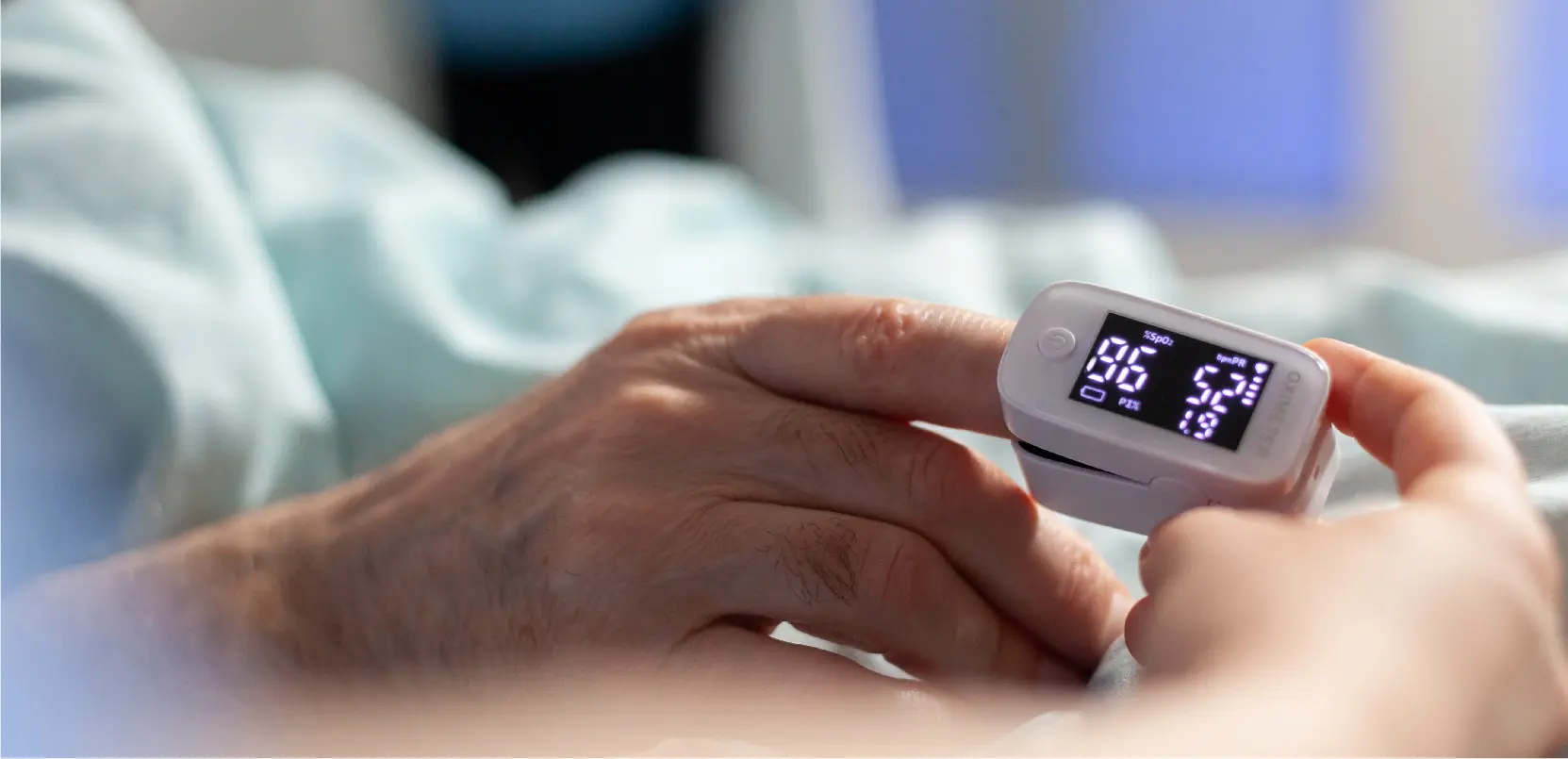

A pulse oximeter might seem like just a small clip for your finger, but it’s actually a gateway to understanding a crucial aspect of your health: oxygen levels. This tiny device, often found in a doctor’s office or purchased for home use, can tell you a lot about how well your body is functioning. Let’s start with the basics of what a pulse oximeter is and why knowing your oxygen saturation is vital to your health.
A pulse oximeter is a small, lightweight device used to monitor the amount of oxygen carried in the body. This non-invasive tool attaches painlessly to your fingertip, sending two wavelengths of light through the finger to measure your pulse rate and how much oxygen is in your blood.
It’s a quick and hassle-free method of gauging your oxygen saturation level, providing essential insights into your health in just a few seconds. Particularly useful for individuals with conditions that affect blood oxygen levels, pulse oximeters have become a staple in both clinical settings and home health monitoring.
Understanding the significance of the readings can help in early detection of health issues that might require further medical examination. The device displays a percentage that represents the oxygen saturation of your blood; a reading of 95% or higher is generally considered normal for most people. However, for individuals with certain health conditions, these numbers can be critically different.
Using a pulse oximeter correctly is crucial for getting accurate readings of your blood’s oxygen levels and your heart rate. To start, it’s essential to prepare your hands properly. Ensure your fingernails are clean, dry, and free from any polish, acrylics, or artificial tips. This step is vital because the oximeter uses light passing through your fingernail to measure oxygen saturation, and any obstruction could skew the results
Once your fingernail is prepped, warm up your hands if they feel cold. Cold hands can lead to inaccurate readings due to reduced blood flow. Find a comfortable position and allow yourself to relax for about five minutes before you proceed.
This resting period helps stabilize your body’s readings. Attach the oximeter to the fingertip of your index or middle finger, ensuring it fits snugly but doesn’t pinch. Remain as still as possible; movement can cause the device to give fluctuating readings.
Wait for at least a minute or until the numbers on the display stabilize and stop changing. You will see two numbers: one indicating your oxygen saturation level (SpO2) and the other your heart rate (HR). Each will be clearly labeled, making it easy to understand and record your health data. After noting down your readings, gently remove the device from your finger and store it safely for next time.
Pulse oximetry tests provide an estimate of the amount of oxygen your blood is carrying, and while they are generally accurate, the precision depends on the quality of the equipment used. Medical-grade oximeters, like those found in hospitals or clinics, offer results within a narrow accuracy range of 4 to 6 percent, as required by the Food and Drug Administration (FDA).
According to the American Thoracic Society, a healthy individual typically has an oxygen saturation level of more than 89 percent. This level signifies that a sufficient amount of oxygen is being transported to the cells throughout your body, which is essential for maintaining cellular health. Oxygen saturation levels temporarily dipping below this threshold might not lead to immediate health issues, but consistent or repeated low readings could signify a problem.
For most healthy people, an oxygen saturation level of 95 percent is deemed normal. If the oximeter shows a reading of 92 percent or lower, it could be an indication of hypoxemia, a condition characterized by dangerously low levels of oxygen in the blood. It’s important to note that various factors, including skin tone, can affect the accuracy of pulse oximeter readings. Understanding these nuances can help you better interpret the results and decide when it might be necessary to seek medical advice.

Here’s a breakdown of the Pulse Oximeter Reading Chart with explanations for each range:
Normal (SpO2 95%–100%, Pulse Rate 60–100 bpm):
Continue Monitoring (SpO2 95%, Pulse Rate 101–109 bpm):
See Your Healthcare Provider (SpO2 93%–94%, Pulse Rate 110–130 bpm):
Go to the Emergency Room or Call 911 (SpO2 92% or lower, Pulse Rate 131 or higher):
Perfusion Index (PI), displayed on some pulse oximeters, is a measurement of your peripheral perfusion. In simpler terms, it reflects the strength of your pulse or how well blood is flowing in the spot where you placed the oximeter (usually your fingertip).
Here’s a breakdown of PI:
There isn’t a universally established “normal range” for Perfusion Index (PI) by age on pulse oximeters. However, PI readings typically range from 0.02% to 20%. Here’s a general idea:
A pulse oximeter can show fluctuations in your heart rate, but it doesn’t necessarily measure these fluctuations directly. Here’s a breakdown:
Pulse Rate vs. Heart Rate Variability:
Fluctuations on a Pulse Oximeter:
Possible Causes of Apparent Fluctuations:
When to Worry about Fluctuations:
Keeping a close eye on your blood oxygen levels (SpO2) and pulse rate is crucial for maintaining overall health, especially for those with respiratory conditions or engaging in strenuous activities. A pulse oximeter is a convenient tool for monitoring these vital signs at home.
Global Touch LLC is proud to offer a range of high-quality pulse oximeters designed for accurate and easy measurement of your SpO2 and pulse rate. Our user-friendly oximeters provide quick and reliable readings, allowing you to stay informed about your health and well-being.
Talk to an Expert Now